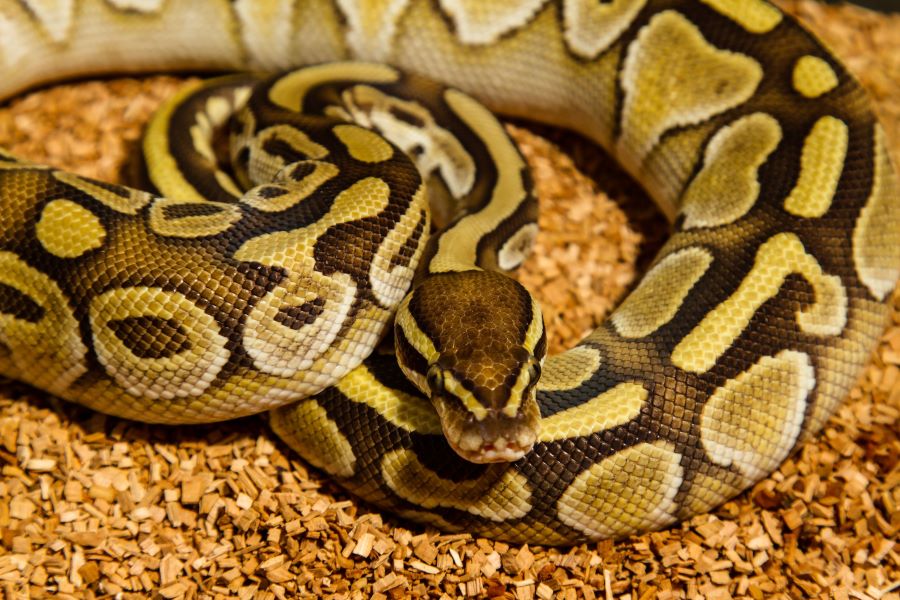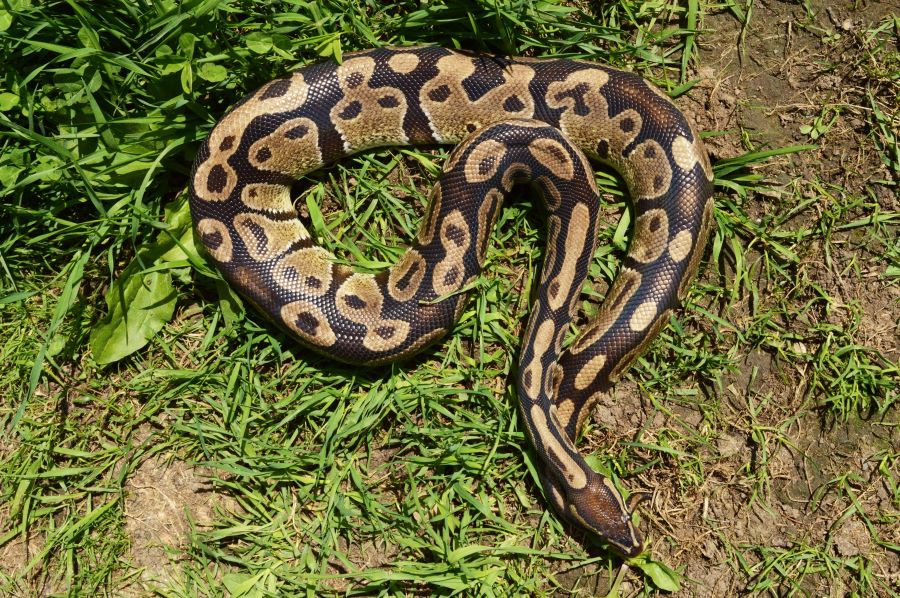What Feeder Mice Do I Feed My Ball Python
New owners often find themselves overwhelmed by the information available on how much and what type of prey to feed their ball python. This confusion can, at times, lead to their ball pythons being under- or overfed, or not being provided with the right nutrients for survival.
Mice are commonly described as a ball python's favorite food, but how many mice should you actually feed your ball python?
Adult ball pythons should be fed 2-5 adult feeder mice every two weeks. Hatchlings or small ball pythons should be fed 1-4 pinkies every 5 to 7 days, while juvenile snakes (less than 1-year-old) should be offered one adult mouse per week.
In this article, we explore exactly how many mice you can feed a ball python at a time, how long to wait between feedings, what time of day is best for feeding, as well as whether or not a ball python can be overfed.

What Size Mice Should I Feed My Ball Python?
When determining how many mice to feed your ball python, two factors come into play – the size of the mice, and the age of your ball python. [Source]
Hatchling and juvenile ball pythons should be fed pinky mice. Pinky mice are simply baby mice who aren't yet covered in fur.
Pinkies are preferred for young ball pythons as eating any prey wider than their body would make them more likely to regurgitate or choke on it.
Adult ball pythons follow a similar rule. They should never be fed prey that is bigger than their body circumference. This, however, allows owners to easily feed their adult ball pythons fully-grown mice.
How Many Mice Should I Feed My Ball Python At A Time?
Most young ball pythons won't manage eating more than one mouse at a time. This is because they aren't quite long enough to fit more than one mouse into their digestive tract without issue.
Juvenile ball pythons would do well with one adult mouse instead of pinkies.
Adult ball pythons, however, should be fed between two to five adult feeder mice at a time.
This really depends on the size of the adult as well as the snake's appetite. Many average-sized adult ball pythons do well with three mice at a time. Unusually large snakes will need more.
How Often Should I Feed My Ball Python?
Once again, this depends on the snake's age. Hatchlings and small juvenile ball pythons should be fed at least once a week.
Once every five days would also be acceptable if you notice they aren't growing at the rate they should, or seem to be looking for more to eat after feeding.
Adult ball pythons can, on average, be fed every two weeks. This too depends on the snake's appetite.
If you suspect three adult mice may not be enough every two weeks, try feeding every week or every 10 days. Increase the number of mice fed per feeding session if this still leaves your ball python looking hungry.
If you're not sure what a hungry ball python looks like, keep reading. It is covered below.
Should I Feed My Ball Python Live Mice?
Although live prey is acceptable, it is not recommended for captive ball pythons.
The mice, especially adult ones, might bite or scratch the snake when it constricts or strikes it. This could cause dangerous infections that are easily avoided by feeding either freshly killed or frozen mice. [Source]
If the mice are frozen, make sure they are completely thawed at room temperature before placing them in the enclosure.
Does Shedding Affect How Much I Should Feed My Ball Python?
When preparing to shed its skin, most ball pythons' appetites will decrease drastically. Some will still eat during the early stages of shedding, though, and it is recommended you offer it a mouse on its usual schedule in case it is hungry.
Most ball pythons will stop eating entirely once the shedding begins and may refuse to eat until they lose their eye caps.
There's no danger in offering a shedding ball python food, just don't be worried if it isn't interested in it at all.

At What Time Should I Feed My Ball Python?
Ball pythons are nocturnal snakes, meaning they are active at night and sleep through most of the day.
Assuming you have a day-night cycle of lights set up in your ball python's enclosure, you may notice it is far more active after sunset (once you switch to infrared). In the wild, this is when ball pythons would begin their hunt for food.
Feeding ball pythons after sunset or late at night is the best choice.
Many ball python owners have noticed their snakes have a much better feeding response when presented with prey at night.
This may not be true for all ball pythons, but it can be determined with a little trial and error.
How Long Does It Take For A Ball Python to Digest a Mouse?
Depending on the size and number of mice fed to a ball python, it could take anywhere between 24 – 72 hours for their meal to be digested at optimum temperatures.
Variation from the optimum temperature range in the enclosure could result in this time being extended to up to five days. It is also largely snake-dependent.
Most snake owners know that once a snake has digested its food it should poop soon after.
This is not the case with ball pythons. Some may take over a week after being fed to decide to poop.
This is not a cause for alarm, and it shouldn't be an issue if they haven't pooped up to two weeks after eating.
You do not need to wait for your ball python to poop to feed it again. Feeding should be done on a consistent schedule as long as the ball python appears healthy.
Rest assured the mice have been digested by day six, and the only reason your ball python hasn't pooped is probably that it is has given in to one of its many quirks.
How Long Can a Ball Python Go Without Food?
In the wild, many adult ball pythons can survive for over 6 months without food. Some hardy individuals have even been recorded to go without a meal for more than a year!
They do this by lowering their metabolic rate immensely, thereby reducing their need for energy from food.
Captive ball pythons should never be left this long without being fed.
Young ball pythons, especially, should not go more than two weeks without food.
This doesn't mean they can't survive more than two weeks without eating, it just means doing so could result in lethargy and an abnormal growth rate.
Adult ball pythons can be left without food for up to a month, maybe two, in captivity. However, this is not the best practice and shouldn't happen to captive ball pythons except in extreme cases.
If you want to keep your ball pythons active, alert, happy, and healthy, it is important to feed them regularly and not test the limits of their ability to live without food.
Can You Feed a Ball Python Too Much?
Just like humans, it is possible to overfeed snakes.
This usually happens when a ball python rejects food but is then force-fed by an owner who feels worried over their snake's reduced appetite.
This can also occur when the mice fed to a ball python are consistently too large. It is one of the reasons owners should vary the time between feedings, as well as the sizes of the mice they are offering their snake.
Too much food, or feeding a ball python too often, could result in it becoming obese. This is more common than you may imagine and can cause serious problems for the snake.
That's why it is important to tailor your feeding schedule to your snake's personal preferences and ensure you are feeding it the right amount at the right time.
How Do I Know When My Ball Python is Hungry?
There are several indicators that your pet ball python could be hungry. The most obvious one is increased activity.
This could take the form of the ball python moving around its cage more often than usual. It could also manifest itself in the fact that your ball python follows movement outside its tank, a habit picked up as it learns you must approach the cage to feed it.
Another sign of a hungry ball python is more frequent tongue flicking.
A snake flicks its tongue to identify its surroundings as well as to search for prey.
So if you see your ball python flicking its tongue much faster than usual there's a good chance it is hungry and looking for something to eat.
My Ball Python Won't Eat. What's Wrong and What Should I Do?
If your snake has a suddenly reduced appetite and refuses food, there are several reasons this may have come about.
These include:
- Stress – from moving into a new enclosure, too much handling, or not enough space to burrow.
- Different Prey – if your ball python is usually fed mice and you suddenly switch to new prey it might refuse to eat for some time.
- Shedding – as mentioned earlier, most snakes will stop eating during the time they are shedding. This will continue until its eye caps have fallen off.
- Temperature – if the tank temperature is too low (outside of the 88-92 degree Fahrenheit range), your ball python's metabolism will slow down and it won't react well to food.
In most cases reverting to the prey your ball python is used to, and ensuring the tank is warm enough, will resolve any feeding issues. If your snake still refuses to eat you may need to examine it for disease or parasites or take it to a vet.
Video on getting a picky ball python to eat.
Other Than Mice, What Can I Feed My Ball Python?
Mice and rats are ball pythons' ultimate favorite prey. They could easily live their entire life eating only mice and rats, but that is not entirely necessary.
If you want to give your ball python a greater variety of prey, you can consider the following:
- Large crickets – this is usually reserved for smaller, baby ball pythons, and not adults.
- Chicks – they offer some variety and a more interesting form of prey for ball pythons. They should be fed alongside more substantial mice.
- Quails – fowl is a good option to provide variety in a snake's diet and quail makes a good-sized alternative to mice.
- Hamsters and Guinea Pigs – although seen as a rather cruel alternative to mice since they are considered pets, hamsters and guinea pigs are excellent options if the need arises to feed it something other than mice.
Some ball pythons may even accept fish in lieu of their usual diet of mice. This should not be a regular occurrence, however, as mice and rats will forever be their most preferred source of food.
Conclusion
Ball pythons of any age make low-maintenance pets. They do not require complicated feeding schedules, are happy to stick to mice and rats most of the time, and can go for long periods without any food whatsoever. They are easy to please and nearly never fussy.
As long as a basic feeding schedule is followed, the right size prey is chosen, and you pay attention to your ball python's behavior and mood, ensuring it eats enough at the right time is incredibly simple.
Source: https://mercurypets.com/how-many-mice-should-i-feed-my-ball-python-solved/
0 Response to "What Feeder Mice Do I Feed My Ball Python"
Post a Comment